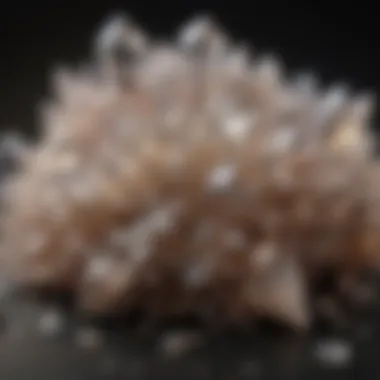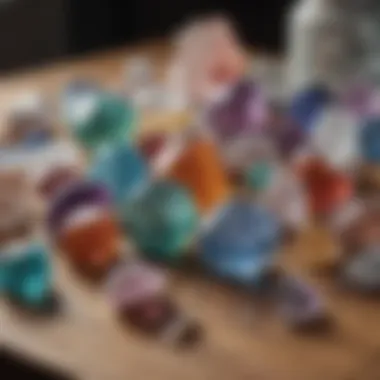A Comprehensive Guide to Cleaning Crystals


Intro
Cleaning crystals is a practice that balances art and science. Proper cleaning techniques preserve the stones' natural beauty while also enhancing their longevity. Ensuring that crystals are cleaned according to their unique properties is paramount. This guide serves to illuminate various methods of cleaning crystals, shedding light on both traditional techniques and modern approaches.
In the following sections, we will discuss the importance of maintaining crystals and the proper strategies for cleaning them without degrading their quality. Emphasis will be placed on understanding the characteristics of different crystals to choose an appropriate cleaning method effectively.
Rock and Fossil Identification
Understanding the unique attributes of crystals and rocks is foundational to their care, including cleaning. Proper identification involves recognizing different types of crystals, which can be varied in composition, structure, and hardness.
Types of Crystals
- Quartz: Widely available, known for its clarity.
- Amethyst: A purple variant of quartz, prized for its color.
- Citrine: Yellow to brownish quartz; often used in jewelry.
- Fluorite: Available in multiple colors; notable for its fluorescence.
Characteristics to Look For
Identifying crystals relies on a few key characteristics:
- Color: The hue can offer immediate insight into its type.
- Transparency: Varies greatly; aids in identification.
- Hardness: Checked using the Mohs scale, it tells how resistant the crystal is to scratching.
- Luster: The quality of light reflection can reveal more about the mineral.
Tools for Identification
Utilizing the right tools can significantly enhance identification:
- Magnifying Glass: For fine details.
- Hardness Kit: Useful for determining scratch resistance.
- Field Guide: Comprehensive resources listing various crystal types and their descriptions.
Cleaning Techniques
Once identification is complete, the next step involves cleaning. Each type of crystal has its preferred cleaning method.
Water and Soap
For many types of crystals, a gentle wash with warm water and a mild soap is effective.
- Method: Mix a small amount of soap in water, dip a soft cloth, and gently wipe the surface.
- Avoid: Prolonged exposure to water.
Salt Cleaning
Salt is useful for certain stones but should be used sparingly.
- Method: Create a paste using salt and water; apply and rinse.
- Consideration: Test on a small, inconspicuous area first.
Considerations for Different Crystals
Some crystals require specific care:
- Selenite: Avoid water; dust with a dry cloth.
- Malachite: Use a damp cloth to clean; do not soak.
Tools and Common Interactions
While cleaning can often be straightforward, understanding interactions can prevent damage.
- Chemicals: Avoid harsh cleaners; opt for natural solutions.
- Soft Brushes: Can help in reaching crevices for deeper cleaning.


Closure
With the right techniques, cleaning can be a simple yet effective process that refreshes crystals, enhancing their visual appeal. Clarity and cleanliness go hand in hand, underscoring the necessity of informed cleaning practices for crystal collectors.
As you delve into this practice, remember to always consider your specific crystal's needs and preferences. This knowledge not only prolongs the life of your specimens but also enriches your overall collecting experience.
Prelude to Crystal Cleaning
Cleaning crystals is an essential practice for anyone who collects or appreciates these natural wonders. It not only enhances their aesthetic appeal but also contributes to their longevity. When dust, grime, or residues accumulate on the surface of crystals, they can lose their vibrancy and beauty. Proper cleaning methods ensure that these specimens maintain their integrity over time.
Moreover, not all crystals react the same way to cleaning methods. Understanding the properties of each type of crystal is crucial when deciding on an appropriate cleaning technique. This section outlines why it is important to clean crystals and provides foundational knowledge that will assist collectors in selecting appropriate cleaning methods for their specific specimens.
Why Clean Crystals?
The act of cleaning crystals serves several purposes. First, it allows the crystal's natural beauty to shine through. Many collectors cherish the intricate details, colors, and patterns of their specimens. Without regular cleaning, the build-up of dirt and oils can obscure these features.
Second, cleaning preserves the value of the crystal. Many collectors view crystals as investments. Keeping them clean can enhance their market value and appeal. Additionally, some crystals are believed to hold particular energies or properties. Cleaning can help maintain the energetic integrity of these stones, ensuring they function as intended.
Lastly, regular cleaning is a sign of respect for the crystals. By caring for them properly, collectors acknowledge the natural beauty and history contained within each piece.
Understanding Crystal Properties
Not all crystals have the same hardness or chemical composition. Understanding these properties is crucial when choosing a cleaning method. For instance, quartz crystals are generally more durable than softer varieties such as selenite, which can easily be damaged by water. Each crystal type has specific traits that can influence how it should be cleaned.
Here are some factors that collectors need to consider:
- Hardness: Crystals vary in hardness, which can be measured on the Mohs scale. Harder crystals withstand physical cleaning better than softer ones.
- Solubility: Some crystals dissolve in water or react to certain chemicals. Knowing whether a crystal is vulnerable to specific elements is important.
- Translucency: Crystals like amethyst have vibrant colors that can fade if not cared for.
By comprehensively understanding these properties, collectors can make informed decisions about how to clean each of their crystals effectively. This knowledge lays a solid foundation for the subsequent sections that outline specific cleaning techniques and tips.
Common Types of Crystals
Understanding common types of crystals is crucial for collectors. Each crystal exhibits unique properties that can affect the cleaning methods and care procedures applied. In this section, we delve into the specifics of several popular crystals. By familiarizing yourself with these varieties, you can ensure that your cleaning approach does not inadvertently damage any of your specimens. Additionally, the characteristics of these crystals contribute to their overall aesthetic appeal and significant value. Let’s explore each type in more detail.
Quartz
Quartz is one of the most prevalent minerals on Earth, easy to find and often used in various applications. Its clarity and hardness make it a popular choice for collectors. When cleaning quartz, one should prefer a mild soap solution. Using an abrasive cleaner can scratch the surface and diminish the crystal's luster. Rinsing under lukewarm water is generally safe, but always inspect for any cracks or inclusions beforehand.
Amethyst
Amethyst is a beautiful purple variety of quartz. Due to its relatively high level of durability, it is suited for gentle water washing with mild soap. However, prolonged exposure to strong sunlight can cause fading. Hence, during cleaning, avoid using hot water or harsh chemicals. Keep in mind that improper care could lead to irreversible damage. Always ensure to rinse thoroughly to remove all soap residue after the process.
Citrine
Citrine, a yellow to brownish-orange quartz, has a reputation for being cheerful and warm. The cleaning of citrine should be done with care to preserve its vibrant hues. A soft cloth is often sufficient for light dirt, while a mixture of water and mild soap helps with deeper cleaning. However, citrine can be sensitive to extreme heat or sudden temperature changes. Therefore, be careful to keep its exposure to fluctuating conditions limited during and after cleaning.
Obsidian
Obsidian, a naturally occurring volcanic glass, possesses its own set of cleaning challenges. While it is quite durable, it can chip or break under pressure. The suggested cleaning method includes a simple wash with lukewarm water and a non-abrasive cloth. Avoid any harsh chemicals as they can dull its shiny finish. Attention to detail is vital here, as smooth surfaces with small scratches can lead to a dull appearance.
When handling delicate crystals, it is wise to prioritize gentle methods. Always assess individual needs before undertaking any cleaning procedure.
Assessing Crystal Condition
Assessing the condition of your crystals is a crucial step before initiating any cleaning process. Understanding their current state helps in determining which cleaning method will be most effective and safe. Each crystal possesses unique characteristics, and improper assessment could potentially lead to damage during cleaning.


Knowing whether a crystal requires only surface cleaning or deeper cleaning allows collectors to maintain the integrity of their specimens. Surface cleaning refers to the removal of dirt and dust that accumulate over time, whereas deep cleaning involves more intensive methods that can address embedded residue and stains. Understanding this difference is significant—not all crystals can withstand deep cleaning methods, and knowing the right approach can prolong a crystal's lifespan and visual appeal.
Benefits of thorough condition assessment include:
- Preventing Damage: Identifying fragile areas or existing flaws reduces the risk of further damage during cleaning.
- Tailored Cleaning Approaches: Different types of crystals react differently to various cleaning methods. By assessing their condition, you can choose optimal techniques, thereby enhancing their beauty without sacrificing safety.
Surface Cleaning vs. Deep Cleaning
Surface cleaning is often sufficient for crystals that are not extensively soiled. This method typically involves using a soft cloth dampened with water or a mild soap solution. It is gentle and focuses mainly on the external layers, ensuring no harsh treatment is placed on the crystal. Simple cleaning techniques, such as wiping with a microfiber cloth, can effectively remove light debris without the risk of scratching or damaging the crystal's surface.
In contrast, deep cleaning is necessary for more heavily soiled crystals or those that have been exposed to elements like oil, dust, or pollutants. This process might require a more vigorous solution or even the use of an ultrasonic cleaner in some cases. However, deep cleaning should be approached with caution as it might expose underlying damage or weaken the crystal structure if done incorrectly.
Identifying Damage
When assessing crystal condition, it is essential to identify any pre-existing damage or weaknesses, as such issues can significantly affect how the cleaning process should be approached.
To identify damage, consider these factors:
- Visual Inspection: Look for cracks, chips, or fractures that may compromise the crystal's integrity.
- Testing Hardness: Gently tapping the crystal to listen for differences in sound can indicate internal damage. A dull sound may suggest a compromised structure.
- Feeling for Smoothness: Run your fingers over the surface to feel for uneven or rough patches that could signify deeper issues.
Being observant during this assessment can prevent common mishaps. Crystals like Amethyst or Citrine can be particularly sensitive. Collectors must avoid using abrasive materials or overly powerful cleaning agents on these types to avoid exacerbating existing flaws.
"A well-maintained crystal not only looks good but also retains its metaphysical benefits over time."
Properly evaluating your crystal condition sets the foundation for effective cleaning strategies. It is the first step in ensuring that your collection remains both beautiful and intact.
Essential Cleaning Supplies
Cleaning crystals effectively requires an understanding of the essential supplies that will keep them looking their best. Each type of crystal may respond differently to cleaning methods, so preparation with the right supplies is crucial. By using appropriate materials, collectors can enhance the longevity and visual quality of their specimens.
Water and Soap Solutions
Water is the most basic and essential element when cleaning crystals. It helps to remove dust and surface grime without damaging the stone. For more effective cleaning, a gentle soap solution can be highly beneficial. Avoid harsh chemicals, which can harm a crystal's surface.
- pH-neutral soap: Typically used as it won’t react with most minerals.
- Distilled water: Recommended to avoid minerals found in tap water.
Combine these elements to create a solution that effectively cleans while being gentle on the material. Remember that some crystals can be water-sensitive. Always check if your crystal can be safely immersed.
Natural Cleaners
Natural cleaning solutions can be an effective and safe alternative to chemical cleaners. They minimize the risk of damaging crystals and offer a more eco-friendly approach.
- Vinegar: A diluted solution of vinegar and water can clean many crystals, but be cautious as some may not react well.
- Baking soda: Another gentle solution, effective for tougher grime on certain surfaces.
- Essential oils: Some collectors use essential oils, but ensure they are compatible with your crystal type.
These options often yield good results while respecting both the crystal’s integrity and the environment. Always test any cleaning solution on a small, inconspicuous area first.
Soft Cloths and Brushes
The type of cloth or brush used in the cleaning process is as important as the cleaning solution. Soft tools prevent scratching and ensure a gentle touch.
- Microfiber cloths: Ideal for polishing crystals without leaving lint or scratches.
- Soft-bristled brushes: Perfect for getting into crevices without causing damage. Toothbrushes can work well, but ensure they are new and clean.
Using the right tools not only enhances the effectiveness of your cleaning efforts, but also preserves the unique features of each crystal. Maintaining the beauty of crystal specimens requires careful attention to the supplies utilized for cleaning.
Cleaning Techniques


Cleaning techniques are crucial for maintaining the integrity and visual appeal of crystals. Each method has its own advantages and is suited for different types of crystals. A thorough understanding of these techniques can help collectors preserve the beauty of their specimens while ensuring that they do not cause any damage. When selecting a cleaning method, factors such as the crystal's hardness, porosity, and surface texture play a significant role. Making informed decisions on how to clean can also enhance the longevity of the crystals, making them more enjoyable to display or use in various applications.
Washing with Water
Washing crystals with water is often the simplest and most effective method of cleaning them. Using lukewarm water helps in removing surface dirt and residue without risking damage. Crystals such as quartz and amethyst respond well to water cleaning. It is important to gently rub the surface with fingers or a soft cloth to dislodge any stubborn dirt. Some collectors prefer to use a soft brush for this task, particularly for more intricate surfaces or larger specimens. However, always ensure you know the specific properties of the crystal, as certain crystals, like selenite, can be damaged by prolonged exposure to water.
Using Soap Solutions
Using soap solutions can provide an additional level of cleanliness that water alone might not achieve. A mild, non-abrasive soap is essential for this method. Diluting soap in warm water creates a gentle solution that can lift tougher grime. When applying the solution, it is important to limit contact time with the soap to prevent any residue from being left behind. A soft cloth or brush should be used to apply the solution to the crystals, followed by thorough rinsing with clean water. Ultimately, soap solutions can be very effective for crystals like citrine or obsidian, as they are generally more resilient against soap damage.
Ultrasonic Cleaning
Ultrasonic cleaning involves using high-frequency sound waves to produce tiny bubbles in a liquid cleaning solution. This cavitation process effectively removes dirt and grime from the crystal surfaces. It is particularly beneficial for crystals with intricate designs or those that may have embedded dirt. However, caution is required, as some crystals, especially softer ones like turquoise, may not withstand ultrasonic cleaning. Always check the manufacturer's guidelines or consult a crystal expert before using this method to avoid unintentional damage.
Avoiding Harmful Chemicals
When cleaning crystals, it is vital to avoid harmful chemicals that can damage the surface or alter the crystal's appearance. Many commercial cleaning products contain abrasives or acids that may scratch or etch crystals. Always prioritize the use of natural cleaners or mild soap solutions instead. Furthermore, ensuring that cleaning tools, such as brushes or cloths, are soft and non-abrasive will prevent scratching and other forms of damage. The goal should be to maintain the crystal's natural beauty without introducing potential harm.
"The essence of cleaning crystals lies in respecting their unique properties. Always research a specific crystal before applying any cleaning method."
Choosing the right cleaning technique will contribute significantly to the overall condition of your crystals and prolong their life and beauty.
Post-Cleaning Care
Post-cleaning care is a vital part of maintaining the aesthetic and structural quality of your crystals. After the cleansing process, a crystal is often vulnerable. It may have absorbed moisture, and the natural energy flow can be temporarily altered. Implementing effective post-cleaning techniques ensures that your crystals not only look their best but also continue to function as expected.
Drying Techniques
Proper drying techniques are critical after cleaning crystals. Many crystals can be sensitive to prolonged moisture. Using air drying is typically the most recommended method. However, there are a few strategies to consider:
- Air Drying: Place the crystal on a soft cloth or a drying rack indoors, away from direct sunlight. Sunlight can cause colors to fade or, in extreme cases, can cause thermal stress.
- Drying Cloths: Soft, lint-free cloths are useful for gently blotting away excess water. Ensure the cloth does not contain dyes or chemicals which could affect the crystal.
- Avoid Heat Sources: Do not use hair dryers or heaters to dry crystals. Excessive heat can lead to cracks or damage.
- Desiccant Packs: For moisture-sensitive crystals, consider using desiccant packs. These can help absorb any excess moisture without direct heat and are particularly useful for porous stones.
Storing Cleaned Crystals
Once crystals are clean and dry, proper storage is essential. Storing them correctly not only maintains their appeal but also protects them from potential damage. Some tips for effective storage include:
- Protective Cases: Boxes with soft interiors or padded cases can shield crystals from scratches. Avoid placing different types of crystals together without separation to prevent scratches and abrasions.
- Stable Environment: Store crystals in a stable environment, away from extreme temperatures and humidity levels. Fluctuating conditions can lead to damage over time.
- Avoid Direct Sunlight: Similar to drying, direct sunlight should be avoided during storage as it can fade colors over time.
- Labeling: For collectors, labeling the crystal types can be beneficial for quick identification, especially when dealing with various stones.
"Well cared for crystals not only retain their beauty but also their energy. Proper post-cleaning care is a crucial step in this process."
Implementing these techniques for drying and storing crystals will help maintain their natural beauty and integrity, ensuring they remain a cherished part of any collection.
Ending
Cleaning crystals is more than just a routine task; it is a practice that ensures the longevity and beauty of your specimens. This article has elaborated on the critical steps and techniques that every collector should consider to maintain their crystals. From understanding their specific properties to applying suitable cleaning methods, each aspect is crucial.
Recap of Recommended Practices
To summarize the key points discussed throughout this guide on cleaning crystals:
- Assess Crystal Condition: Evaluate whether your crystal needs surface or deep cleaning based on its condition.
- Choose Appropriate Cleaning Supplies: Use gentle, non-toxic water and soap solutions, and avoid abrasive materials.
- Employ Suitable Cleaning Techniques: Opt for washing with water when possible, or use ultrasonic cleaning for delicate items, always avoiding harsh chemicals.
- Ensure Proper Drying and Storage: After cleaning, dry the crystals carefully and store them in a way that prevents damage.
By adhering to these recommendations, collectors can ensure that their crystals remain in optimal condition over time.
Encouragement for Ongoing Care
The work does not stop once your crystals are clean. Regular maintenance is essential in preserving their beauty. Consider creating a cleaning schedule that aligns with how often you display or handle them.
Also, take note of any signs of discoloration or dirt buildup as indicators that cleaning is needed. Regular inspection can almost always prevent larger issues from arising. Collectors should foster a habit of ongoing care, as it greatly enhances the experience and value of each crystal. To learn more, you might refer to additional resources such as Wikipedia, Britannica, and discussion forums like Reddit.
"The beauty of crystals lies not just in their form, but in the care we provide them."







